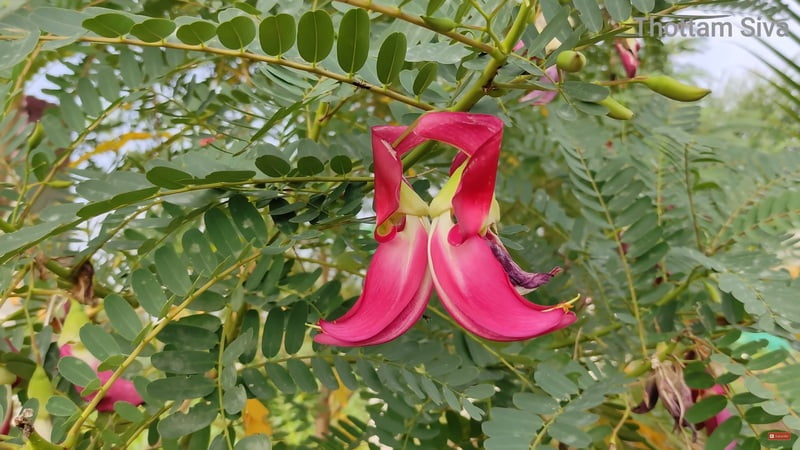



Humming Bird Tree Red Leaves (சிகப்பு அகத்திகீரை )
Customize
Product Details
சிகப்பு அகத்திகீரை (Red Amaranth) என்பது ஒரு பசும்பச்சிலை வகையாகும். இது அகத்தி (Amaranth) இனத்திற்கு உட்பட்ட செடியாகும், மற்றும் இது பொதுவாக உணவுக்கான பயிராக வளர்க்கப்படுகிறது. செடி மற்றும் அதன் இலைகள் செறிவு, நிறம் மற்றும் அதிக அளவில் ஊட்டச்சத்துக்கள் கொண்டுள்ளன.
சிகப்பு அகத்திகீரையின் பன்முகநிலை பயன்கள்:
உணவுக்கான பயன்பாடு:
- சிகப்பு அகத்திகீரை இலைகள் மற்றும் கொம்புகள் மிகவும் ஊட்டச்சத்துப்பூர்வமானவை. இதில் பிரோட்டீன், விட்டமின் A, விட்டமின் C, இரும்பு, மற்றும் கால்சியம் போன்ற ஊட்டச்சத்துகள் மிகுந்துள்ளன.
- இந்தக் கீரை இலைகள் நறுக்கிய அல்லது வேகவைத்து உணவில் பயன்படுத்தப்படுகின்றன. அதேபோல், சிக்கன், மீன், அல்லது மற்ற வகையான உணவுகளுடன் சேர்க்கவும் செய்யலாம்.
ஆரோக்கியத்திற்கு பயன்பாடு:
- நிறைவான ஊட்டச்சத்துகள்: சிகப்பு அகத்திகீரை செறிந்த கலோரிகள் மற்றும் ஆன்டி-ஆக்ஸிடென்டுகளுடன் கூடியது, இதனால் நோய் எதிர்ப்பு சக்தி அதிகரிக்க உதவுகிறது.
- உறுப்பு சீரமைப்பு: இதில் உள்ள விட்டமின் C மற்றும் மற்ற தாதுக்கள் செரிமானத்திற்கு உதவுவதுடன், உடலில் உள்ள செரிவுகளையும் சரிசெய்ய உதவுகிறது.
- உள்ளீடுகள் மற்றும் இரத்தக் குறைபாடுகள்: இது இரத்தத்தில் உள்ள ஹெமோகுளோபினை மேம்படுத்துவதற்காக அறியப்படுகிறது, ஏனென்றால் இதில் இருக்கும் இரும்பு மிக முக்கியமானது.
இரும்பு மற்றும் கால்சியம்:
- இந்த கீரை இரும்பு மற்றும் கால்சியத்துடன் குளிக்கின்றது, இதனால் எலும்புகள் மற்றும் பல் சுத்தம் மற்றும் வலிமைப்படுத்துவதற்கு உதவும்.
- இது இரத்தம், பங்கு, மற்றும் மொத்த உடல் செயல்பாடுகளுக்கு உதவும்.
பொதுவான மரபுவழி மருத்துவ பயன்பாடு:
- சில இடங்களில், சிகப்பு அகத்திகீரை புற்றுநோயின் எதிர்ப்பு அல்லது மரபுவழி சிகிச்சைகளுக்கு பயன்படும். குறிப்பாக, அதில் உள்ள ஆன்டி-ஆக்ஸிடென்டுகள் தீவிர நோய்களுக்குத் தற்காப்பாக作用 செய்யலாம்.
சாதாரண பாகங்கள்:
- தாடி: இதன் தாடி உள்துறையில் அழகுக்காக பயன்படுத்தப்படுவதாக அறியப்படுகிறது.
- கீரை: இலைகளும், கொம்புகளும் உணவுக்காக பயன்படுத்தப்படுகின்றன.
சிகப்பு அகத்திகீரை பரிமாற்றம், உடல் நலம் மற்றும் வித்தியாசமான விளைவுகளைக் கொண்டுள்ளது. எனவே, இது பல்வேறு பயன்கள் கொண்ட ஒரு மிகவும் முக்கியமான செடியா ஆகிறது.
The Hummingbird Tree (often referred to as Erythrina species, particularly Erythrina crista-galli) is a type of flowering tree that is known for its vibrant red flowers, which attract hummingbirds. While this tree is commonly associated with its colorful blooms, the leaves can also contribute to its striking appearance.
Key Characteristics of Hummingbird Tree (Erythrina species):
- Red Flowers: The tree gets its name from the bright red, tubular flowers that appear in clusters and attract hummingbirds.
- Red or Green Leaves: The leaves of the tree are usually broad and can be green or have a reddish tint, especially as they mature or during seasonal changes.
- Tropical/Temperate Adaptability: Some species of Erythrina are native to tropical regions, while others can grow in temperate climates.
- Deciduous Nature: Erythrina trees often shed their leaves in the winter, which may cause the leaves to turn a reddish color before falling off.
Red Leaves in Hummingbird Trees:
- Seasonal Change: During colder months or as part of their natural growth cycle, the leaves may shift in color, taking on a reddish hue before dropping.
- Stress Response: Sometimes, red leaves can indicate stress, such as from insufficient water, nutrient imbalances, or pests. However, this is not always a cause for concern.
These trees are not just valued for their attractive flowers but also for their ability to provide nectar for hummingbirds. If you're noticing red leaves specifically, it could be a combination of seasonal changes or environmental factors affecting the tree.
1. Aesthetic Appeal:
- Visual Beauty: The red leaves, particularly when they appear in the fall or during specific growth stages, add a striking visual element to the landscape. They create a vivid contrast with the green foliage and red flowers, making the tree stand out in gardens and parks.
- Seasonal Interest: The transformation of the leaves into red hues before they fall can provide seasonal color changes, adding beauty throughout the year.
2. Ecological Benefits:
- Attracting Hummingbirds: While the flowers of the tree are more famous for attracting hummingbirds, the overall health of the tree, including its leaves, helps to support a habitat that is beneficial to these birds. The rich foliage provides cover, and the flowers provide nectar.
- Pollinator Support: The hummingbirds and other pollinators that are attracted to the tree help with the pollination of nearby plants and contribute to the overall health of the ecosystem.
3. Medicinal Uses (in Some Cultures):
- While red leaves themselves aren't typically used in traditional medicine, parts of the Hummingbird Tree (such as flowers, bark, or roots) are known to have medicinal properties in certain cultures, particularly in South America. For example:
- Erythrina species have been used in folk medicine to treat ailments such as pain, inflammation, and respiratory issues. However, any medicinal use should be approached with caution, as some parts of the plant can be toxic if not prepared properly.
4. Cultural Significance:
- In some cultures, the Hummingbird Tree, especially Erythrina crista-galli, is considered a symbol of beauty, vitality, and energy. The tree’s bright red flowers and, occasionally, red-tinted leaves, can be seen as a symbol of power and life.
- In addition to its ornamental value, the tree can have symbolic meaning in landscaping or botanical gardens, where it might represent vibrant life, renewal, or connection with nature.
5. Soil Health & Nitrogen Fixation:
- Some species of Erythrina are nitrogen-fixing plants, meaning they can improve soil health by converting nitrogen from the air into a form that plants can use. This helps enrich the surrounding soil, promoting healthier growth for other plants in the vicinity.
6. Shade and Shelter:
- The large, dense foliage (including red-tinged leaves) offers excellent shade. This can help reduce the temperature in surrounding areas, especially in hot climates. The leaves also provide shelter for various small animals and insect

